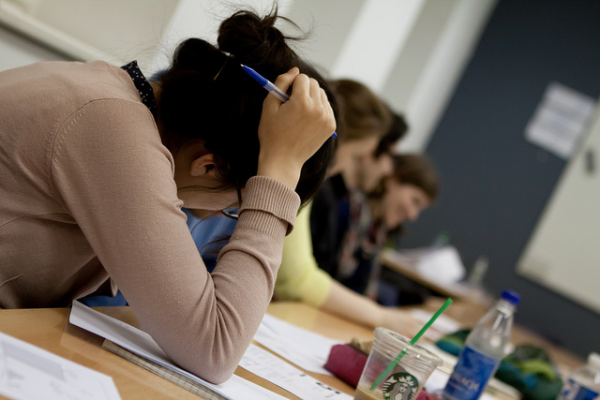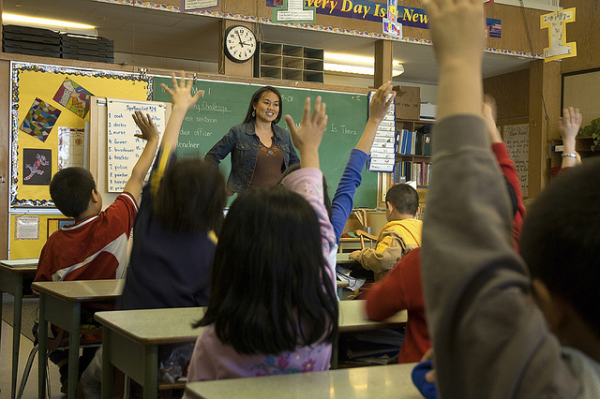Julia Cremin is a 6th grade Reading, Language Arts and Math teacher at O'Keeffe Middle School in Madison, WI. She is certified in Elementary Education (grades 1-9) with a minor in Mathematics. This is her fourth year teaching middle school.
"5 Things I Wish I'd Known My First Year of Teaching"
This fall marks my fourth year teaching middle school, and I’m thrilled to say that I actually don’t feel completely overwhelmed at the thought of 25 faces, filled with anticipation and optimism about the upcoming school year, staring at me on the first day. I’ll be the first to admit that my first few years of teaching have been no trip to the school playground. According to a 2012 Education Week article, 40-50% of teachers leave the profession within their first five years of teaching. However, with the support of my family, friends and colleagues; I’m proud to say I haven’t become a statistic.
During my education courses in college I was inundated with teaching advice from my professors, advisors, and cooperating teachers. However, over the past three years, I’ve gleaned more general wisdom through experience that has made my life during the school year more manageable. What follows are some of my universal take-aways: I hope they will help you during your first few years.
1. Connect with other educators
 Teachers spend the majority of their day in their classroom with their students, often times the only adult in the room. It is essential for your mental wellbeing to get together with other teachers in informal settings, either during lunch or outside of school hours.
Teachers spend the majority of their day in their classroom with their students, often times the only adult in the room. It is essential for your mental wellbeing to get together with other teachers in informal settings, either during lunch or outside of school hours.
My first year, I had students in my room almost daily during lunch, as a consequence for missing assignments or misbehavior. In hindsight I realize that this was more of a punishment for myself than for the students.
Now I eat lunch with my other team teachers. During this time we occasionally discuss students, or upcoming lessons and school events. It is extremely reassuring to learn that the same student who can’t help but blurt out no matter how many times I teach (and reteach) how to respond appropriately, and how many different consequences I give, is demonstrating the exact same behavior in his other classes. It’s not just me!
More frequently our conversation turns to weekend plans, the latest episode of House of Cards, or the book we are currently reading. This break in the day helps me let go of any negative interactions in my classroom and provides a mental respite from the hundred-mile-an-hour pace my brain must keep throughout the rest of the day.
2. Learn to let go
 This was one of the hardest lessons I had to learn. There will always be a way that I can tweak a lesson to allow for more student engagement, another e-mail I can send to update a parent on a student’s progress, or another student writing sample that I can assess to guide my instruction. At some point, however, I learned that I had to draw the line because there are only so many hours in the day.
This was one of the hardest lessons I had to learn. There will always be a way that I can tweak a lesson to allow for more student engagement, another e-mail I can send to update a parent on a student’s progress, or another student writing sample that I can assess to guide my instruction. At some point, however, I learned that I had to draw the line because there are only so many hours in the day.
The strategy that helps me prioritize what is essential is to record my never-ending tasks on to-do list. (I personally find that 4”x6” Post-it® notes are the perfect size and shape for these lists). This may sound simple, but seeing each idea of what “needs” to be accomplished in writing helps me as I tackle the list. If I start with the most critical tasks and cross items off as they are completed, I automatically spend my time on the most important, time-sensitive items. This ensures that I finish what absolutely needs to be done by tomorrow, and I can work on the other items on the list when I have spare time during the evenings or weekends.
Inevitably there are some things that I just don’t have time to get around to. Luckily there is always next year!
3. Intentionally build teacher-student relationships
 I learned this last school year, when I had a late transfer student added to my class in mid-October. All of my students were on the same page as far as academic and behavior expectations and we had started to hit a rhythm. Then, there was a knock at the door and our school counselor entered with Anna*, our new student. Hair tied back in a braid, with a pink and purple backpack, Anna was the picture of innocence, and her behavior matched that, for the first day and a half.
I learned this last school year, when I had a late transfer student added to my class in mid-October. All of my students were on the same page as far as academic and behavior expectations and we had started to hit a rhythm. Then, there was a knock at the door and our school counselor entered with Anna*, our new student. Hair tied back in a braid, with a pink and purple backpack, Anna was the picture of innocence, and her behavior matched that, for the first day and a half.
Mid-way through Day 2, Anna’s true personality started to show. Her angelic disposition faded away to show a rough-around-the-edges, manipulative and negative personality. Her toxic nature slowly seeped its way into the rest of the classroom causing negativity and discord. By late November, it was apparent that something had to be done.
I met with our school’s Positive Behavior Intervention and Support (PBIS) coach to discuss the issue and she offered to observe a few classes so she could help me problem solve. After about a week’s worth of observations we had a follow-up meeting. During this time the PBIS coach shared with me a strategy called 2-Minute Interventions.
The 2-Minute Intervention involves pulling a student aside for 1-2 minutes daily, for at least two weeks straight. The purpose of these conversations are to check in with the student about what is going on in their life, and to compliment them about something (anything) positive you have noticed about them. I started having these interventions with Anna and after just a few days I noticed improvements in her behavior. We actually started to form a positive relationship and came up with ways for her to become a constructive leader in the classroom.
Let me be clear that the change did not occur overnight and we definitely had our setbacks throughout the year. Ultimately, Anna and I forged a pretty strong relationship. We even had lunch dates once a week where we completed different craft projects while listening to her favorite Pandora radio stations. This simple solution helped me to reaffirm what I already knew: When students are acting inappropriately it is because they are seeking attention. A strategy like a 2-Minute Intervention gives these students the attention they need in an appropriate way and can save the whole class from exposure to inappropriate behavior outbursts that interfere with learning.
*name has been changed to protect the not-so-innocent
4. Take a break
 Like most teachers, after a day of teaching, attending meetings, following up with parents, and straightening up my classroom, I still have a couple of hours of grading or prep work to complete before the bell rings to mark the start of the next day. Rather than keep myself at school until the sun sets, I find it is helpful to pack up work I can do at home and leave school when after-school activities have concluded.
Like most teachers, after a day of teaching, attending meetings, following up with parents, and straightening up my classroom, I still have a couple of hours of grading or prep work to complete before the bell rings to mark the start of the next day. Rather than keep myself at school until the sun sets, I find it is helpful to pack up work I can do at home and leave school when after-school activities have concluded.
At this time, I either strap on my running shoes and hit the pavement, or I attend a 4:00 hot yoga class. Both of these activities give me the physical and mental break that I need to process what happened during the day and provide me with a boost of norepinephrine and endorphins to clear my brain and prepare it to take a fresh look at the work I have ahead of me for the evening.
5. Your plans will fall apart
 “The best laid plans of mice and men often go awry.” There is no place where this rings more true than in the classroom. No matter how many hours are spent on creating an engaging hook, providing ample time for student-to-student interaction, and incorporating the newest-fangled technological device into a lesson, there will be days when that lesson will come crashing down to a pile of smoking rubble on the classroom floor. It is essential to keep in mind that this is not a reflection of you or your abilities as a teacher.
“The best laid plans of mice and men often go awry.” There is no place where this rings more true than in the classroom. No matter how many hours are spent on creating an engaging hook, providing ample time for student-to-student interaction, and incorporating the newest-fangled technological device into a lesson, there will be days when that lesson will come crashing down to a pile of smoking rubble on the classroom floor. It is essential to keep in mind that this is not a reflection of you or your abilities as a teacher.
These really tough days will happen throughout your career, but as a teacher in your first few years, it is hard to recognize that these collapses come with the territory of teaching and are completely normal. The best advice is to identify what you could have done differently, recognize what was a result of students being students, and then set it all aside so you can prepare for a fresh start the next day.
To all of the new teachers: I hope this advice proves helpful during your first few years in the classroom.
For those of you with more classroom experience: What do you know now that you wish you would have known during your first few years?
Image Credits:
http://goo.gl/kdh42E
http://goo.gl/vnrghn
http://goo.gl/AifXLa
http://goo.gl/sjp5TF
http://goo.gl/V5L8W3






![[Lesson Plan Activity] ELL Bingo](https://content.cdntwrk.com/mediaproxy?url=https%3A%2F%2Finfo.variquest.com%2Fhubfs%2F3D%2FLesson_Plan_Pics%2Fell%2520bingo%2520header.png&size=1&version=1753195128&sig=ebc051ac021c1960f75e8f80a97d9355&default=hubs%2Ftilebg-blogs.jpg)
![[Lesson Plan] First Day of School Feelings](https://content.cdntwrk.com/mediaproxy?url=https%3A%2F%2Finfo.variquest.com%2Fhubfs%2Fimages%2FProducts%2FCutout_Maker%2Fthe%2520start%2520of%2520a%2520new%2520school%2520year%2520cutout%2520maker.jpg&size=1&version=1752780346&sig=847b11606c169458fea71bb69e2360e0&default=hubs%2Ftilebg-blogs.jpg)
![[Lesson Plan Activity] Kindness Calendar](https://content.cdntwrk.com/mediaproxy?url=https%3A%2F%2Finfo.variquest.com%2Fhubfs%2F3D%2FLesson_Plan_Pics%2Fkindness%2520calendar%2520header.png&size=1&version=1752703157&sig=3fa07390d2b175137c148d7763d6a980&default=hubs%2Ftilebg-blogs.jpg)





![[Lesson Plan] Celebrate the Chinese New Year 2025!](https://content.cdntwrk.com/mediaproxy?url=https%3A%2F%2Finfo.variquest.com%2Fhubfs%2FCarman%2FCNY%25201-2018%2F%25E6%2581%25AD%25E5%2596%259C%25E7%2599%25BC%25E8%25B2%25A1.png&size=1&version=1737070708&sig=d89d716a42e2737ee7122119d2052225&default=hubs%2Ftilebg-blogs.jpg)


![[Lesson Plan] Election Activities for Grades 2-6](https://content.cdntwrk.com/mediaproxy?url=https%3A%2F%2Finfo.variquest.com%2Fhubfs%2FLesson_Plan_PDFs%2Felections%2520lesson%2520plan%2520header%2520blog.png&size=1&version=1730049507&sig=c8f9bdb2545ac4d7408ee3c224f15b3d&default=hubs%2Ftilebg-blogs.jpg)





![[Lesson Plan] Arbor Day Activities for Grades 4-6](https://content.cdntwrk.com/mediaproxy?url=https%3A%2F%2Finfo.variquest.com%2Fhubfs%2FLesson_Plan_PDFs%2Farbor%2520day%2520activities%2520blog%2520header.png%23keepProtocol&size=1&version=1713281322&sig=fa93c6558caab80b84ee1b7a3f74e75c&default=hubs%2Ftilebg-blogs.jpg)
![[Lesson Plan] SEL Photo Activities for Grades 5-7](https://content.cdntwrk.com/mediaproxy?url=https%3A%2F%2Finfo.variquest.com%2Fhubfs%2FLesson_Plan_PDFs%2FSEL%2520Photo%2520Activities%2520header.png%23keepProtocol&size=1&version=1712432018&sig=36043467659cdc58fd01a7c4e0b4e10f&default=hubs%2Ftilebg-blogs.jpg)